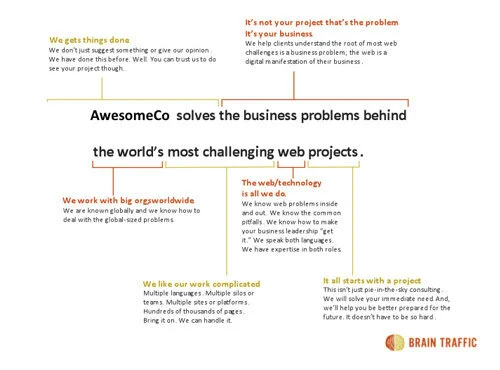How a Messaging Hierarchy Streamlines Your Marketing
You may have missed this post on how to build a high-quality messaging hierarchy for your marketing efforts when we first published it back in 2020. We are re-posting it now with updated guidance and a newly revised marketing messaging framework to stand out from the competition.
As a boutique hybrid marketing and public relations firm, The Forum takes on many projects for our clients to serve their long-term goals. Immediate benefits are great, but it’s also important to play the long game and ensure your brand has staying power. One of these to-dos with years of potential impact (barring necessary refreshes) is the messaging hierarchy. It is a tool designed to create structure in achieving those goals for many years to come.
You may also hear this work referred to as a brand messaging framework, messaging pillars, or messaging goals. All encompass the same essential work; to craft messaging guidance that builds upon your positioning statement and keeps all outbound marketing efforts in lockstep as a result. And it begins with a question: What does your company do, and how does it serve its customers?
What is A Brand Messaging Hierarchy?
At the head of the messaging hierarchy is a brand promise. This goes deeper than any tagline; it describes the very thing you achieve for the client, every single time. The positioning statement normally comes second, followed by the value prop, value description, and key messaging and proof points.
The hierarchy can either be mapped out graphically or represented in text. Either way, it begins with the simplest concepts and grows in detail as it moves into the details of extended messaging. We prefer utilizing both imagery and language to illustrate our messaging hierarchy maps. Think of it as the building of a house; would you begin construction without a floor plan? Launching a business without filling out that messaging hierarchy template takes a similar risk.
Here is an example from a presentation by Kristina Halvorson, the owner of Brain Traffic, titled “Message and Medium: Better Content by Design.” Watch the full video here. It’s a few years old but still highly relevant.
The goal is to create a resonant, intelligent narrative. The messaging hierarchy represents what your business does, how it does it, and the pain point(s) you resolve for the customer. Any lack of clarity is a no-no, because that indicates a fuzziness that will also pervade the rest of your marketing efforts. To shape content that delivers—it must point back clearly to the pyramid you constructed above.
Why Bother with a Messaging Hierarchy, Anyway?
It’s worth asking: can the messaging hierarchy be skipped? The answer is no, and it’s based on our years of experience watching brands grow with the help of a properly architected hierarchy and floundering without it. Business expansion and rebranding can also benefit from the hierarchy process. If your company’s marketing personas are particularly siloed, a hierarchy can be versioned for each of those target audiences.
We’d argue that building a messaging framework is now more important than ever before. Our exposure to products and services has never been higher. We are receiving dozens, if not hundreds, of marketing messages a day influencing our habits as consumers. If your expertly-crafted message isn’t a part of that dialogue, you’re missing out.
A Positioning and Messaging Framework Exercise
We encourage you to take on the building of a messaging hierarchy as a company challenge at the next virtual happy hour; how many of your employees can fill it out without a lot of head-scratching? Follow these instructions:
Set the Stage
Gather your stakeholders together and introduce exercise. You’ll also need someone in charge; this should be a person outside the PR and marketing organization or a consultant. You want the clarity of purpose that comes from an individual not directly involved in this particular arena. They need to spell out the end goal; to come to a team consensus on the entire messaging hierarchy “pyramid” before the exercise is over.
Introduce the Rules
Some ground rules that can be helpful: emphasize collaboration and visual brainstorming. MURAL is one of our favorite options that work just as well for virtual meetings. Set a time limit, and a word limit too. The brand promise, for example, should stay under about 240 characters.
Distribute Worksheets
Index cards, a MURAL screen, a giant pyramid printout, etc.; distribute the materials needed and begin. Prompts can also make a difference—a dictionary, thesaurus, and a couple of excellent marketing books can provide inspiration. Set a timer and remind the team to meet deadlines at set intervals.
Save the Work
Even the stuff that doesn’t quite fit should be saved. It’s easier to define who your business serves if you understand who it does NOT apply to. Don’t put the exercise results to a vote; a marketing messaging hierarchy isn’t determined by group consensus. But pay attention, however, to what resonates with the team at large! The responses that receive resounding enthusiasm should be of interest to the C-Suite.
A consistent story is the end goal. It is of vital importance for businesses with 10, 50, or 50,000 employees. Infuse it with character, too. If your company is quirky and thinks outside the box, your message hierarchy shouldn’t be stodgy and dull. (Actually, no one’s message hierarchy should be stodgy and dull.)
Next steps: contact us for a 30-minute consultation and we can get to work together. Whether you are starting a messaging hierarchy from scratch or refining a framework that’s 90% of the way there, our agency can assist. We’ll help in pulling out the key points and building PR and marketing action items that will get you results and accurately represent your brand.



